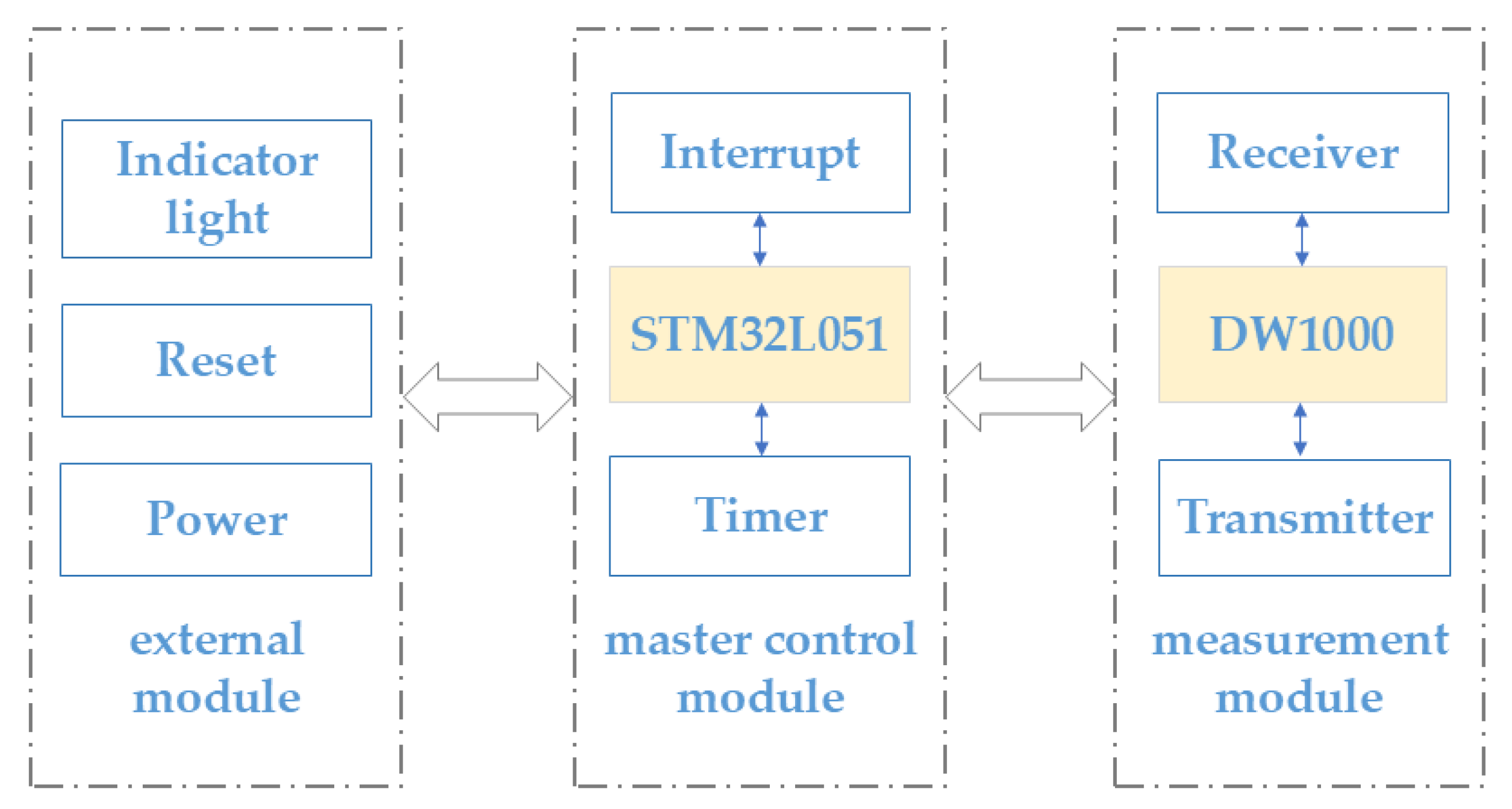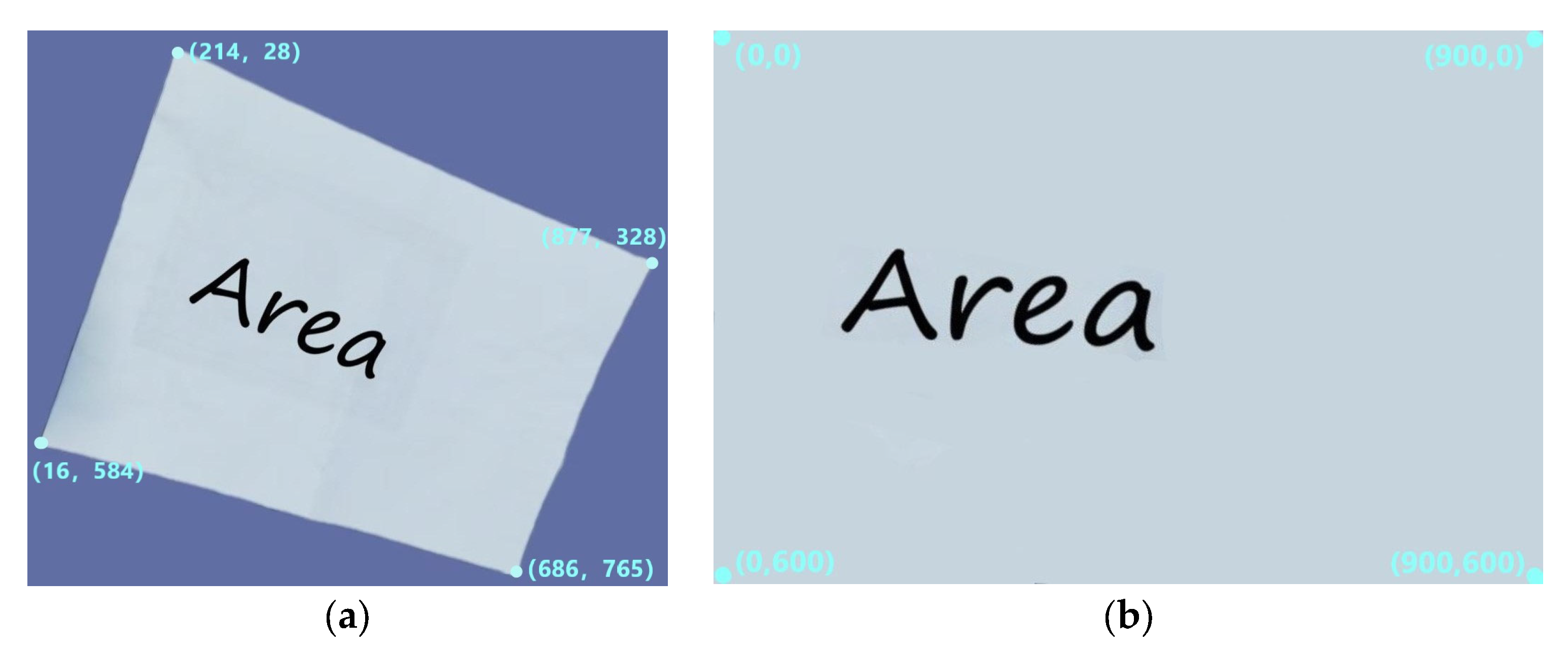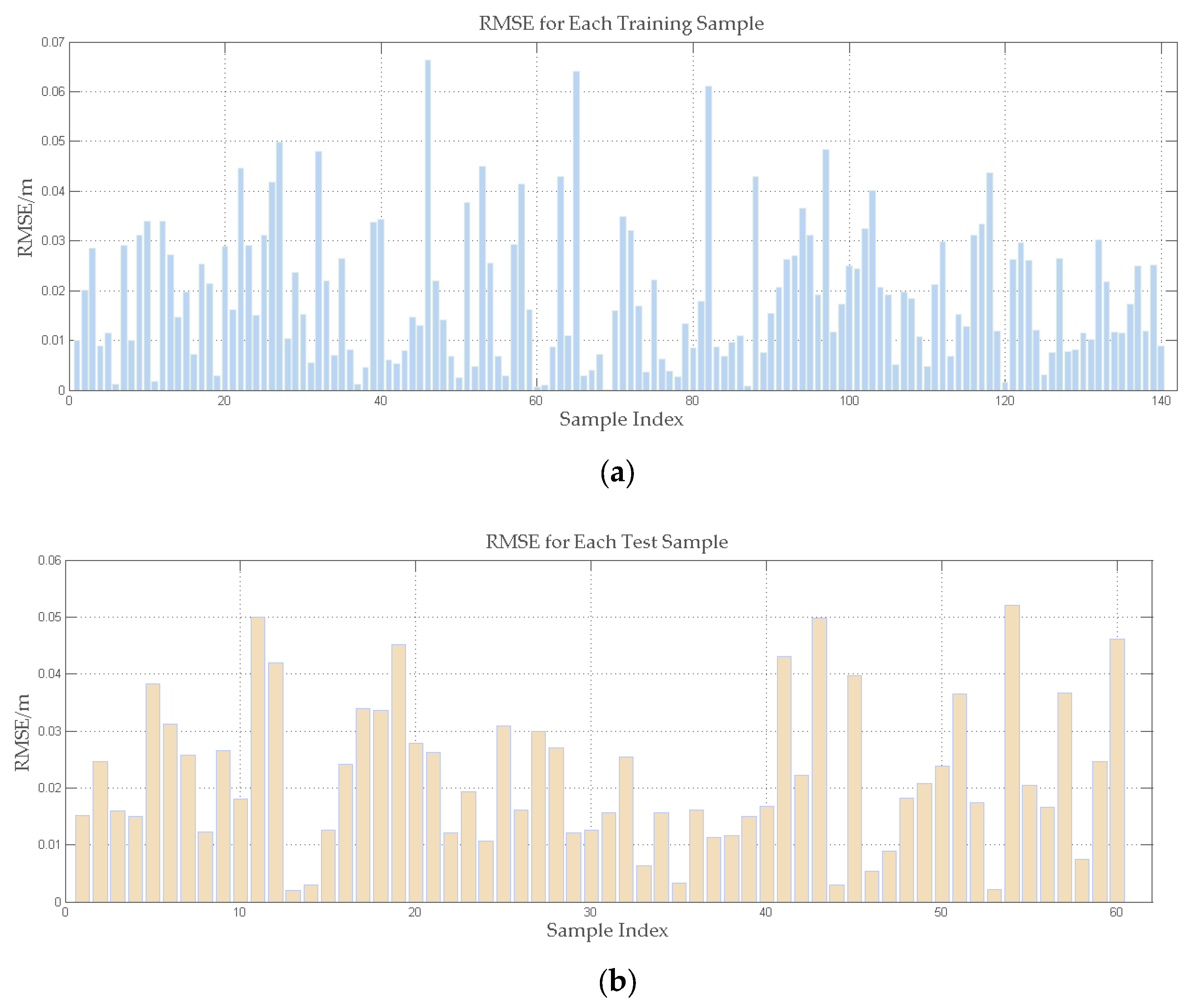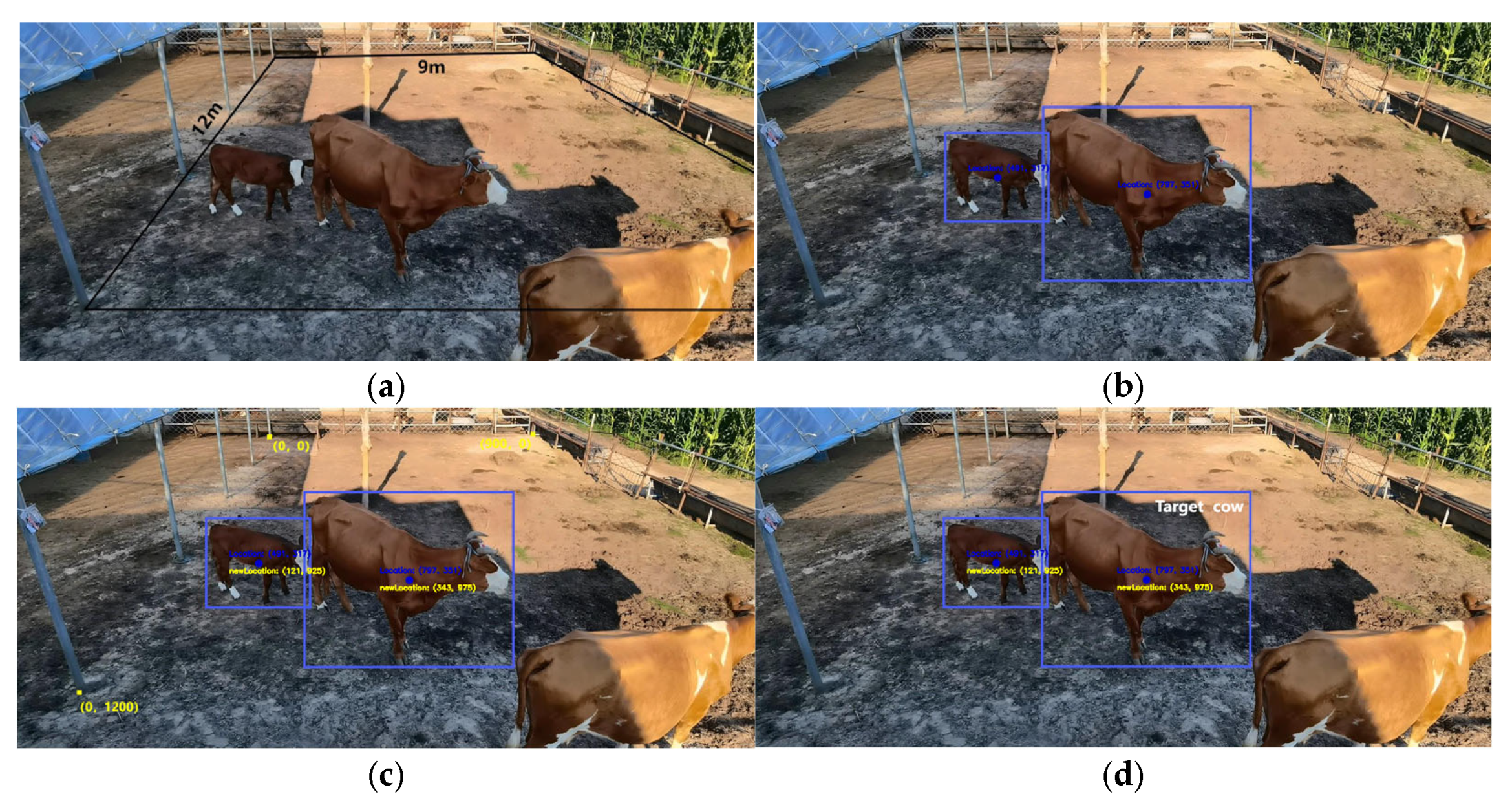Individual Cow Recognition Based on Ultra-Wideband and Computer Vision
Simple Summary
Abstract
1. Introduction
2. Materials and Methods
2.1. Hardware Designs
2.2. Localization Algorithm
2.3. Neural Network Filtering Model
2.4. Transmission Transformation and YOLO Detection
2.5. Evaluation Indicators
3. Results
3.1. Error Compensation Model Effect
3.2. Static Positioning Test
3.3. Individual Identification Results
4. Discussion
4.1. Performance of Individual Recognition Technology
4.2. Further Perspectives on Individual Recognition Technology
- (1)
- The chosen region is tiny since the camera range for this experiment must cover the entire chosen area; therefore, a camera with a longer focal length will be required as the experimental apparatus in the future.
- (2)
- The experimental object that was chosen is small: only one cow was chosen for this experiment; in the real-world scenario, if there were more cows on the cattle farm, the measurement error would be higher. Therefore, in order to improve the experiment’s practicality, the experimental object should be increased.
- (3)
- The cows in this experiment were positioned in two dimensions without taking Z-axis coordinates (height direction) into account. Stated otherwise, the experiment was evaluated only on the basis of planar position, disregarding the cows’ height. The precision of the experimental results, however, can be impacted by the height disparities between the cows when there are several of them.
- (4)
- There are drawbacks to the power supply design. The label’s power supply battery in this experiment is a 5V lithium battery, which requires replacement every few days. The power supply’s design should be further enhanced for better use in real-world situations.
5. Conclusions
Author Contributions
Funding
Institutional Review Board Statement
Informed Consent Statement
Data Availability Statement
Conflicts of Interest
References
- Kaufman, E.I.; Asselstine, V.H.; LeBlanc, S.J.; Duffield, T.F.; DeVries, T.J. Association of rumination time and health status with milk yield and composition in early-lactation dairy cows. J. Dairy Sci. 2018, 101, 462–471. [Google Scholar] [CrossRef] [PubMed]
- Polsky, L.; von Keyserlingk, M.A. Invited review: Effects of heat stress on dairy cattle welfare. J. Dairy Sci. 2017, 100, 8645–8657. [Google Scholar] [CrossRef] [PubMed]
- Tsai, Y.C.; Hsu, J.T.; Ding, S.T.; Rustia DJ, A.; Lin, T.T. Assessment of dairy cow heat stress by monitoring drinking behaviour using an embedded imaging system. Biosyst. Eng. 2020, 199, 97–108. [Google Scholar] [CrossRef]
- Achour, B.; Belkadi, M.; Filali, I.; Laghrouche, M.; Lahdir, M. Image analysis for individual identification and feeding behaviour monitoring of dairy cows based on Convolutional Neural Networks (CNN). Biosyst. Eng. 2020, 198, 31–49. [Google Scholar] [CrossRef]
- Tuan, S.A.; Rustia, D.J.A.; Hsu, J.T.; Lin, T.T. Frequency modulated continuous wave radar-based system for monitoring dairy cow respiration rate. Comput. Electron. Agric. 2022, 196. [Google Scholar] [CrossRef]
- Wang, J.; Bell, M.; Liu, X.; Liu, G. Machine-learning techniques can enhance dairy cow estrus detection using location and acceleration data. Animals 2020, 10, 1160. [Google Scholar] [CrossRef]
- Dolecheck, K.A.; Silvia, W.J.; Heersche, G., Jr.; Chang, Y.M.; Ray, D.L.; Stone, A.E.; Bewley, J.M. Behavioral and physiological changes around estrus events identified using multiple automated monitoring technologies. J. Dairy Sci. 2015, 98, 8723–8731. [Google Scholar] [CrossRef]
- Liu, N.; Qi, J.; An, X.; Wang, Y. A Review on Information Technologies Applicable to Precision Dairy Farming: Focus on Behavior, Health Monitoring, and the Precise Feeding of Dairy Cows. Agriculture 2023, 13, 1858. [Google Scholar] [CrossRef]
- Zhang, R.; Ji, J.; Zhao, K.; Wang, J.; Zhang, M.; Wang, M. A cascaded individual cow identification method based on DeepOtsu and EfficientNet. Agriculture 2023, 13, 279. [Google Scholar] [CrossRef]
- Shen, W.; Sun, Y.; Zhang, Y.; Fu, X.; Hou, H.; Kou, S.; Zhang, Y. Automatic recognition method of cow ruminating behaviour based on edge computing. Comput. Electron. Agric. 2021, 191, 106495. [Google Scholar] [CrossRef]
- Benaissa, S.; Tuyttens FA, M.; Plets, D.; Martens, L.; Vandaele, L.; Joseph, W.; Sonck, B. Improved cattle behaviour monitoring by combining Ultra-Wideband location and accelerometer data. Animal 2023, 17, 100730. [Google Scholar] [CrossRef] [PubMed]
- Feng, W.; Fan, D.; Wu, H.; Yuan, W. Cow Behavior Recognition Based on Wearable Nose Rings. Animals 2024, 14, 1187. [Google Scholar] [CrossRef]
- Bloch, V.; Levit, H.; Halachmi, I. Design a system for measuring individual cow feed intake in commercial dairies. Animal 2021, 15, 100277. [Google Scholar] [CrossRef]
- McDonagh, J.; Tzimiropoulos, G.; Slinger, K.R.; Huggett, Z.J.; Down, P.M.; Bell, M.J. Detecting dairy cow behavior using vision technology. Agriculture 2021, 11, 675. [Google Scholar] [CrossRef]
- Wang, Y.; Mücher, S.; Wang, W.; Guo, L.; Kooistra, L. A review of three-dimensional computer vision used in precision livestock farming for cattle growth management. Comput. Electron. Agric. 2023, 206, 107687. [Google Scholar] [CrossRef]
- Li, T.; Jiang, B.; Wu, D.; Yin, X.; Song, H. Tracking multiple target cows’ ruminant mouth areas using optical flow and inter-frame difference methods. IEEE Access 2019, 7, 185520–185531. [Google Scholar] [CrossRef]
- Okura, F.; Ikuma, S.; Makihara, Y.; Muramatsu, D.; Nakada, K.; Yagi, Y. RGB-D video-based individual identification of dairy cows using gait and texture analyses. Comput. Electron. Agric. 2019, 165, 104944. [Google Scholar] [CrossRef]
- Yujuan, C.; Dongjian, H.; Yinxi, F.; Huaibo, S. Intelligent monitoring method of cow ruminant behavior based on video analysis technology. Int. J. Agric. Biol. Eng. 2017, 10, 194–202. [Google Scholar] [CrossRef]
- Wang, Z.; Wang, S.; Wang, C.; Zhang, Y.; Zong, Z.; Wang, H.; Du, Y. A non-contact cow estrus monitoring method based on the thermal infrared images of cows. Agriculture 2023, 13, 385. [Google Scholar] [CrossRef]
- Weng, Z.; Fan, L.; Zhang, Y.; Zheng, Z.; Gong, C.; Wei, Z. Facial Recognition of Dairy Cattle Based on Improved Convolutional Neural Network. IEICE Transactions Inf. Syst. 2022, 105, 1234–1238. [Google Scholar] [CrossRef]
- Li, J.; Zhang, F. Ultra-Wideband Positioning Technology: Exploring TWR, TDoA, and PDoA Methods for Precise Ranging and Positioning. In Ultra-Wideband Technologies—Diverse Techniques and Applications; IntechOpen: London, UK, 2024. [Google Scholar]
- Shuqin, Y.; Yangqihang, L.; Zhen, W.; Yuanyuan, H.; Yongsheng, W.; Xianyong, L. Improved YOLO V4 model for face recognition of diary cow by fusing coordinate information. Trans. Chin. Soc. Agric. Eng. 2021, 37, 129–135. [Google Scholar]
- Horst, E.A.; Kvidera, S.K.; Baumgard, L.H. Invited review: The influence of immune activation on transition cow health and performance—A critical evaluation of traditional dogmas. J. Dairy Sci. 2021, 104, 8380–8410. [Google Scholar] [CrossRef] [PubMed]
- Chapa, J.M.; Lidauer, L.; Steininger, A.; Hlschuster, M.; Iwersen, M. Use of a real-time location system to detect cows in distinct functional areas within a barn. JDS Commun. 2021, 2, 217–222. [Google Scholar] [CrossRef] [PubMed]
- Porto, S.M.; Arcidiacono, C.; Anguzza, U.; Cascone, G. The automatic detection of dairy cow feeding and standing behaviours in free-stall barns by a computer vision-based system. Biosyst. Eng. 2015, 133, 46–55. [Google Scholar] [CrossRef]
- Tylutki, T.P.; Fox, D.G.; Durbal, V.M.; Tedeschi, L.O.; Russell, J.B.; Van Amburgh, M.E.; Pell, A.N. Cornell Net Carbohydrate and Protein System: A model for precision feeding of dairy cattle. Anim. Feed. Sci. Technol. 2008, 143, 174–202. [Google Scholar]
- Gheller, L.S.; Wagemann-Fluxá, C.A.; DeVries, T.J. Accuracy and precision of diets fed to close-up cows on dairy farms and its association with early lactation performance. J. Dairy Sci. 2024, 107, 10811–10823. [Google Scholar] [CrossRef]
- Kalangia, L.S.; Syaukat, Y.; Kuntjoro, S.U.; Priyanti, A. Factors affecting profit analysis of beef cattle farming in East Java, Indonesia. Development 2016, 28, 12. [Google Scholar]
- Banos, G.; Wall, E.; Coffey, M.P.; Bagnall, A.; Gillespie, S.; Russell, G.C.; McNeilly, T.N. Identification of immune traits correlated with dairy cow health, reproduction and productivity. PloS ONE 2013, 8, e65766. [Google Scholar] [CrossRef]
- Ingvartsen, K.L.; Moyes, K. Nutrition, immune function and health of dairy cattle. Animal 2013, 7, 112–122. [Google Scholar] [CrossRef]







| Number of Hidden Layers | Training Set RMSE/m | Test Set RMSE/m |
|---|---|---|
| 4 | 0.027 | 0.031 |
| 5 | 0.024 | 0.029 |
| 6 | 0.024 | 0.026 |
| 7 | 0.025 | 0.027 |
| 8 | 0.025 | 0.029 |
| 9 | 0.024 | 0.028 |
| Test Points | Real Coordinates/m | Before Filtering Coordinates/m | After Filtering Coordinates/m |
|---|---|---|---|
| 1 | (1.6, 3.6) | (1.655, 3.673) | (1.626, 3.628) |
| 2 | (3, 5) | (3.052, 5.08) | (3.032, 5.034) |
| 3 | (4, 6.5) | (4.065, 6.605) | (4.0281, 6.533) |
Disclaimer/Publisher’s Note: The statements, opinions and data contained in all publications are solely those of the individual author(s) and contributor(s) and not of MDPI and/or the editor(s). MDPI and/or the editor(s) disclaim responsibility for any injury to people or property resulting from any ideas, methods, instructions or products referred to in the content. |
© 2025 by the authors. Licensee MDPI, Basel, Switzerland. This article is an open access article distributed under the terms and conditions of the Creative Commons Attribution (CC BY) license (https://creativecommons.org/licenses/by/4.0/).
Share and Cite
Zhao, A.; Wu, H.; Fan, D.; Li, K. Individual Cow Recognition Based on Ultra-Wideband and Computer Vision. Animals 2025, 15, 456. https://doi.org/10.3390/ani15030456
Zhao A, Wu H, Fan D, Li K. Individual Cow Recognition Based on Ultra-Wideband and Computer Vision. Animals. 2025; 15(3):456. https://doi.org/10.3390/ani15030456
Chicago/Turabian StyleZhao, Aruna, Huijuan Wu, Daoerji Fan, and Kuo Li. 2025. "Individual Cow Recognition Based on Ultra-Wideband and Computer Vision" Animals 15, no. 3: 456. https://doi.org/10.3390/ani15030456
APA StyleZhao, A., Wu, H., Fan, D., & Li, K. (2025). Individual Cow Recognition Based on Ultra-Wideband and Computer Vision. Animals, 15(3), 456. https://doi.org/10.3390/ani15030456





